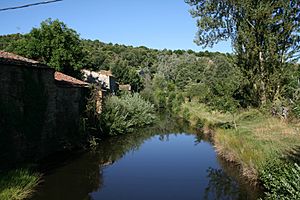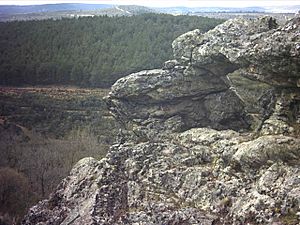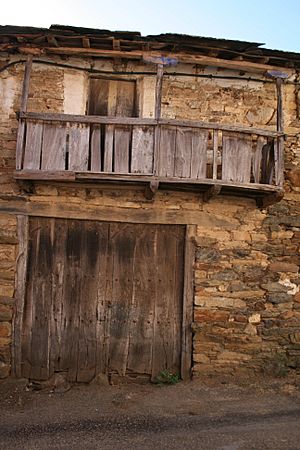Aliste (comarca) facts for kids

Aliste is a special region, called a comarca, located in the west of Zamora province in Spain. It shares a border with Portugal to the west and south. This area covers a large space, about 193,883 hectares. For many years, Aliste was quite isolated, which helped it keep its rich culture and old traditions alive.
Aliste is mostly a rural area, meaning it has many farms and open spaces. Its economy mainly depends on cattle farming. The name Aliste might come from an old word, Alesti, used in a 9th-century book. It referred to the alisos (alder trees) that grow along the banks of what is now called the Aliste River.
One cool fact about Aliste is that it's one of the few places in Western Europe where you can find a good number of wild wolves. These wolves live in the Sierra de la Culebra mountain range, which is in the northwest part of Aliste.
Contents
Discover Aliste's Landscape
The land in Aliste is full of rolling hills and gentle slopes. You'll also see dry areas, similar to those in nearby Portugal. The Aliste River flows through the middle of the region. Near the river, you'll find lots of green plants, oak trees, and bushes.
A big part of Aliste is a national game reserve, covering 65,981 hectares. This reserve is in the Sierra de la Culebra mountains. It's famous for having the largest group of wolves in the whole Iberian Peninsula (Spain and Portugal).
Towns and Villages of Aliste
Aliste is made up of many small towns and villages. Some of these include Alcañices, Fonfría, Mahide, Rabanales, and San Vitero. Each town has its own unique charm and history.
Aliste's Rich Culture
Aliste has a very interesting culture, with many old traditions and historical sites.
Historic Buildings and Art
You can find examples of Romanesque art in the churches here, like in Tábara. There's also an old clock tower in Alcañices and a castle in Riomanzanas. The region also has historical places linked to the Templars, who were a famous group of knights long ago.
Delicious Local Food
Aliste is known for its tasty local food. A special type of local cattle, called Ternera de Aliste, is very famous. People also enjoy pork, especially during traditional festivals where pigs are prepared. These festivals are believed to have started with the early Celtic people who lived here.
Traditional Music and Dance
Music is a big part of Aliste's culture. People often play instruments like the bagpipe, flute, and drum, which is common in the Zamora area. The gaita alistana is a special type of traditional bagpipe from this region. It sounds a bit like bagpipes from nearby areas.
On some Sundays, and during holidays or festivals, locals perform traditional dances, like the jota. When someone plays the drum, they often sing along to the music, with words that fit the dance's rhythm.
Old Customs and Traditions
The customs in Aliste are based on a long history and many old stories. One important cultural event is the annual slaughter of livestock, known as the matanza. This is a big community gathering.
The Alistano Language
Alistano isn't really a separate language, but it's a special way of speaking Leonese. It has its own unique style, influenced by Galician-Portuguese because of how close it is to Portugal. Some people even think that the Alistano way of speaking shows a connection to Portuguese history.
Alistano also has influences from the Galician language. Many parts of Alistan culture have been connected with Galicia for over two thousand years.
It's hard to say what the future holds for Alistano. It's mostly spoken by older people now. More people moving to cities, the spread of mass media, and the use of Castilian (Spanish) as the main language in schools and official places are making Alistano less common.
Here's a small example of Alistano and what it means in Spanish:
|
Example of a dialogue in Alistano:
|
Spanish translation:
|
See also
 In Spanish: Aliste para niños
In Spanish: Aliste para niños






